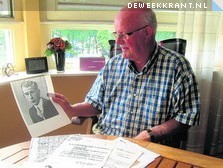
| WAGENINGEN. It's good that there are people who deal with this. The story about the war must be told to the youth, so that such a thing will never happen again. Kees Heij is deeply impressed that the name of his uncle will be visible on Friday 20 September on one of the four nameplates on the Monument for the Fallen on the Costerweg. Cornelis (Kees) van de Kraats. An ordinary and healthy young man from Wageningen who was no older than 22 years old. He was born in Renkum on March 19, 1922, the son of Cornelis van de Kraats and Arendina Wolthoorn. He died on November 28, 1944 at 4.10 am in Hüsum Schwesing , an outside camp of Neuengamme concentration camp ( eighteen kilometers from Hamburg, Germany). He had prison number 49114. Kees van de Kraats was buried on December 2, 1944 in a mass grave on the Ostfriedhof to Husum. Cousin Kees Heij (73) knows that it must have been terrible for his grandmother who was lived at the Sumatrastraat 13 in Wageningen. What had her boy done? Nothing right? Kees van de Kraats was a laboratory assistant at the Agricultural University with Professor Edelman, professor of Soil Science, says Heij. The story goes that Kees refused to work for the Germans. All healthy men received a call to work for the occupier. Kees didn't want to. With fatal consequences. Prison camp Amersfoort. He was arrested on October 26, 1943 and transferred to Camp Amersfoort. There he was placed in Block 10 with the prison number 2649. A number of letters from Amersfoort have been preserved. What surprised me so much is that life just went on there. You think of all kinds of nasty things about a camp, but the letters show that they used to do Sinterklaas celebrations, says Kees Heij, who becomes a bit emotional when telling all kinds of memories. Many things come back with the extension of the years. You used to go on with your life. Not spoken anymore. About Kees was never spoken again. He did not return, that was it. My grandmother must have thought so. It was bad enough for her, she had four children, two boys and two girls. One boy did not return from Germany, the other adventurer Gerrit had left for the Dutch East Indies before the war, survived the camps under the Japanese occupiers and did not return to the Netherlands until the 1960s. |
     |
| English translation and editing by the The Ancestor Company All rights reserved, Thanks to various archive institutions for making certain images and facts available. Copyright © Genealogybos.com 2024 |